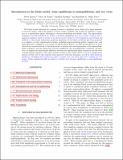Introduction to the Dicke model : from equilibrium to nonequilibrium, and vice versa
Abstract
The Dicke model describes the coupling between a quantized cavity field and a large ensemble of two-level atoms. When the number of atoms tends to infinity, this model can undergo a transition to a superradiant phase, belonging to the mean-field Ising universality class. The superradiant transition was first predicted for atoms in thermal equilibrium, but its experimental realizations required driven-dissipative systems. In this Progress Report, we offer an introduction to some theoretical concepts relevant to the Dicke model, reviewing the critical properties of the superradiant phase transition, and the distinction between equilibrium and nonequilibrium conditions. In addition, we explain the fundamental difference between the superradiant phase transition and the more common lasing transition. Our report mostly focuses on the steady states of single-mode optical cavities, but we also mention some aspects of real-time dynamics, as well as applications to multimode cavities, superconducting circuits, and trapped ions.
Citation
Kirton , P , Roses , M M , Keeling , J & Torre , E G D 2018 , ' Introduction to the Dicke model : from equilibrium to nonequilibrium, and vice versa ' , Advanced Quantum Technologies , vol. Early View , 1800043 . https://doi.org/10.1002/qute.201800043
Publication
Advanced Quantum Technologies
Status
Peer reviewed
ISSN
2511-9044Type
Journal item
Description
P.K. acknowledges support from EPSRC (EP/M010910/1) and the Austrian Academy of Sciences (ÖAW). P.K. and J.K. acknowledge support from EPSRC program “Hybrid Polaritonics” (EP/M025330/1).Collections
Items in the St Andrews Research Repository are protected by copyright, with all rights reserved, unless otherwise indicated.

